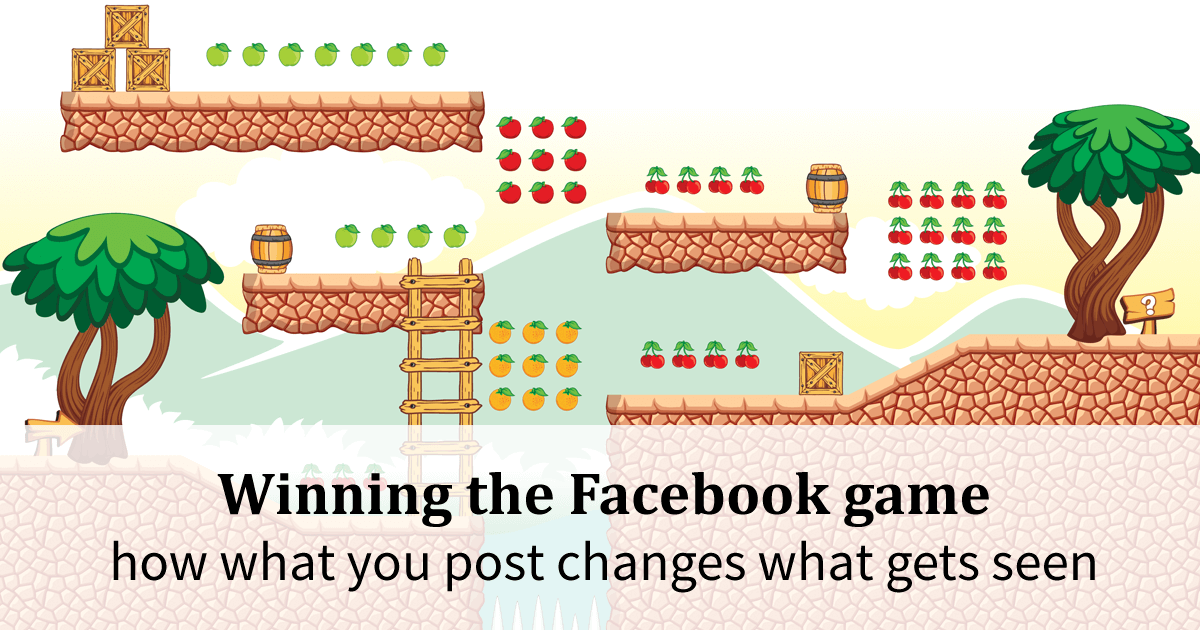
In our last post about Facebook, we discussed that just like your own company, Facebook wants to maximize its profit and isn’t in the business of giving away its product for free. They make their money off selling ads, but they need people to stick around to consume those ads, so they are laser focused on creating the perfect balance between a great Facebook experience and the inclusion of just-enough-but-not-too-much advertising. If you try to rebel and post only advertisements on your business Facebook page, you’ll soon learn that the house always wins as your posts are shown to 0 followers — unless, of course, you are willing to pay for each one of your posts.
But there’s one way in which your goals and Facebook’s goals align perfectly: You both want people to want to read and interact with the content you post. Realizing this is how you start to win the Facebook game.
Play with the house instead of against it
Imagine that you have a bank of points in the Facebook game, that you build up to spend on temporary power ups. We’ll call this your engagement power.
- The more people engage with your content on Facebook, the higher your engagement power meter rises, and the more your content will be visible in your follower’s Facebook feeds.
- The lower your engagement power is, the fewer people will be shown your Facebook posts.
- The actions you take on Facebook either build up your engagement power, or spend it.
- For the purposes of this article, we’ll talk about general concepts rather than specific numbers, because Facebook’s algorithm is changing all of the time, but the underlying concepts stay the same.

 You earn more engagement power by getting people to engage with your content, in the form of likes, comments and shares.
You earn more engagement power by getting people to engage with your content, in the form of likes, comments and shares.
 You lose engagement power by doing things that cause people to spend less time on Facebook – this means posting things that people find boring or abrasive, or by posting links that take people away from Facebook.
You lose engagement power by doing things that cause people to spend less time on Facebook – this means posting things that people find boring or abrasive, or by posting links that take people away from Facebook.
Remember: Facebook wants to keep people on Facebook, by making Facebook as interesting and engaging as possible. If you want to post a link that takes people off of Facebook, that’s going to cost you some of your engagement points, and if you do this too often you will not have any engagement power left.
Let’s build up your Facebook engagement power!
1. Make your content engaging
 If you are producing great how-to articles, inspirational pictures, fun facts, breaking news, cool contests, or some other style(s) of content that people want to read and interact with, you are building both your brand equity and Facebook’s. You get to gain customer trust and stay top of mind, and Facebook gets to keep people on the site a little longer.
If you are producing great how-to articles, inspirational pictures, fun facts, breaking news, cool contests, or some other style(s) of content that people want to read and interact with, you are building both your brand equity and Facebook’s. You get to gain customer trust and stay top of mind, and Facebook gets to keep people on the site a little longer.
The more organic likes, comments and shares your Facebook posts get, the more engagement power you will earn.
2. Try to keep people on Facebook
 Obviously, you need to be able to post some links to your hot summer sales, latest blog posts, and other places on the web that directly benefit your business. But if that’s all you do, you’ll quickly drain your engagement power, and soon find that your posts aren’t seen by anyone. Spend your engagement power wisely, and spread out posts that include links to non-Facebook locations.
Obviously, you need to be able to post some links to your hot summer sales, latest blog posts, and other places on the web that directly benefit your business. But if that’s all you do, you’ll quickly drain your engagement power, and soon find that your posts aren’t seen by anyone. Spend your engagement power wisely, and spread out posts that include links to non-Facebook locations.
We can’t give you an exact ratio of posts that do include links to posts that don’t, because the algorithm changes frequently, and because the quantity of interactions that your posts get play a role in what the ratio will be for you. But aim for at least more than 50% of your Facebook posts not including a link to a different site.
3. Don’t only post links to your own site
 Find articles that are relevant to your audience that come from third-party sources, and mix them into the links that you do post.
Find articles that are relevant to your audience that come from third-party sources, and mix them into the links that you do post.
For example, if you’re an organic food meal service, you could post studies about the health benefits of eating right, news stories about local farmers in your area, and image galleries of gorgeously prepared food. If you’re a plumber, you might offer up articles about funny plumbing disasters, or tips about keeping your pipes from freezing in the winter.
Yes, you could write these things on your own blog, but every now and then you want to highlight someone else’s work; this shows the algorithm (and your followers!) that you aren’t just on Facebook in order to promote yourself, and that you’re interested in providing content that your followers will find engaging even if it comes from a source other than yourself. You may find that links you post about third party websites will frequently be given much wider circulation than articles you wrote yourself. Think of this as being like the social principal that makes referral clients so much easier to close deals with: something nice someone else says about you carries more weight than you just bragging on your own.
(This means that link exchanges with other businesses might be a good thing to organize, too!)
4. Highlight other people’s Facebook posts
 This is very similar to sharing links to articles you didn’t write yourself, and works on roughly the same principal — it shows that you are interested in sharing high quality, useful and interesting content with your followers, not just promoting yourself. But it packs an even greater punch, because it keeps people on the Facebook site instead of sending them to read an article elsewhere. Facebook LOVES that! More engagement power for you!
This is very similar to sharing links to articles you didn’t write yourself, and works on roughly the same principal — it shows that you are interested in sharing high quality, useful and interesting content with your followers, not just promoting yourself. But it packs an even greater punch, because it keeps people on the Facebook site instead of sending them to read an article elsewhere. Facebook LOVES that! More engagement power for you!
5. Include the types of content that are most consumed by Facebookers
 People love to engage with images and videos (especially short, highly aesthetic videos). Even though it can be a little more time consuming and costly to create these types of content, they tend to be served up more often in people’s Facebook feeds, and they attract more likes, comments and shares than pure text on its own.
People love to engage with images and videos (especially short, highly aesthetic videos). Even though it can be a little more time consuming and costly to create these types of content, they tend to be served up more often in people’s Facebook feeds, and they attract more likes, comments and shares than pure text on its own.
Are there notable quotables in your blog posts? Facts and figures that are impressive when they stand alone? An inspiring story or phrase you like to tell in your office? These things can all be put on an eye-catching image to become valuable social media content!
If you publish videos on Youtube, consider not linking to those videos from Facebook – linking to outside videos is especially heavily penalized, and you’ll spend a lot of engagement power for not much visibility. Instead, upload the video directly to Facebook!
Perhaps most powerful of all these days is the relatively new “Go Live” feature, which lets you stream video directly onto Facebook. Facebook loves this, because you’re almost forced to be authentic — there’s no room for editing between different product shots or talking heads. It’s just you, speaking directly to your followers… And there isn’t any need for anyone to leave Facebook. 😉
Spend your power wisely
If you have a great sale or popular blog post to promote, remember to interject other high-value posts that don’t take your followers off of Facebook as part of those campaigns. Otherwise, you will end up spending your engagement power all in one place! At Infinite Synergy Solutions, we try to maintain at least a 3:1 ratio between “Facebook only” posts and those that contain links back to our site (or our client’s sites.)
Keep in mind that you’re not just doing all this to get more credit with Facebook; you’re also building your own credibility with your audience.
Pay to play: skip the “games” and get to business
Of course, if this all sounds like too much effort, you can always simply pay to boost any post and make it drastically more visible either to your followers or a specific site-wide demographic that you choose. Spending some real dollars on Facebook posts you want to make sure get seen without having to play any “games” cuts through the complications.
We recommend a healthy balance between paid posts and organic ones for optimal business usage of Facebook.
Facebook is social media
The common theme here is that Facebook isn’t just an advertising platform, it’s social media. And the heart of social, is, well, being social. Focus on being helpful, informative, friendly, encouraging discussion – maybe even being funny – rather than just posting links to sale items. Strive to be the kind of person that you’d want to do business with when you’re communicating on any form of social media.
In our next post in this series, we’ll examine whether it’s worth going to all this trouble, or if you should be looking at other advertising methods.






Leave A Comment